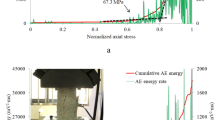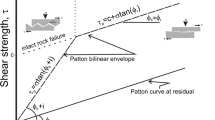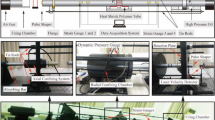Abstract
There is potential danger of conical shear failure surface in karst cave roof under pile foundation load. To understand the mechanical and failure characteristics of rocks under such conditions. In this study, an auxiliary device consisting of an indenter and a hollow support combined with a servo-controlled mechanical equipment was used to perform mixed compression-shear tests. The laboratory tests were studied numerically by finite difference methods. This study set up 4 groups of height variables 20, 30, 40, 50 mm and 3 groups of aperture variables 20, 30, 40 mm. AE (acoustic emission) tests are adopted to study the failure characteristics of specimen. The experimental results show that the peak load increases with the sample height while decreases with the aperture of support. This paper defines an apparent elastic modulus in terms of displacements and loads, which increases with height by 42.12, 51.7, and 49.00 KN/mm for apertures from 20 to 40 mm. The AE data show that the ratio of RA (ratio of rise time to maximum amplitude) to AF (average frequency of AE count) gradually increases as the support aperture increases, indicating that the aperture is approximately close to the radius of the indenter and that shear damage is approximately significant. The numerical simulation results show that the shear stress is the largest at the position where the upper surface of the specimen contacts with the indenter, and the displacement is the largest at the position where the lower surface of the specimen overlaps with the support hole. The extrusion phenomenon caused by dilatation is the main reason for the tensile failure detected during the experiment.




















Similar content being viewed by others
References
Cao X, Tang H, Li H, Sun G (2021) Probability model for embedment of single pile into rock masses at building sites in karst terrain. Arab J Geosci 14(14):1–8
Chen YD, Zhao ZH (2020) Correlation between shear induced asperity degradation and AE energy in single granite fracture. Eng Fract Mech 235:107184
Chen T, Zhao K, Yan Y, Zhou Y, He Z, Guo L (2022) Mechanical properties and AE response of cemented tailings backfill under variable angle shear. Constr Buil Mater 343:128114
Cui Z, Sheng Q, Zhang M, Cao J, Mei X, Luo Q (2021) A new direct shear apparatus for rock joints specialized in cyclic loading. Rock Mech Rock Eng 54(8):4321–4327
Du K, Li XF, Tao M, Wang SF (2020) Experimental study on AE (AE) characteristics and crack classification during rock fracture in several basic lab tests. Int J Rock Mech Min 133:104411
Du K, Li XF, Wang SY, Tao M, Li G, Wang SF (2021) Compression-shear failure properties and AE (AE) characteristics of rocks in variable angle shear and direct shear tests. Measurement 183:109814
Feng Z, Chen J, He J, Huang Z, Dong Y, Jiang D, Meng Y (2020) Study on vertical bearing characteristics of bridge pile foundation in karst area considering the size. IOP Conf Ser Mater Sci Eng 780(2):022003
Huang D, Zhu T (2019) Experimental study on the shear mechanical behavior of sandstone under normal tensile stress using a new double-shear testing device. Rock Mech Rock Eng 52(9):3467–3474
Huang S, Feng XT, Xia K (2011) A dynamic punch method to quantify the dynamic shear strength of brittle solids. Rev Sci Instrum 82(5):053901
Huang D, Cen D, Song Y (2020) Comparative investigation on the compression-shear and tension-shear behaviour of sandstone at different shearing rates. Rock Mech Rock Eng 53(7):3111–3131
Huang J, Tang H, Pan X, Gan Z, Hua W, Dong S (2022) Investigation of the compression–shear fracture propagation for rocks accounting for confining pressure and crack surface friction. Theoret Appl Fract Mech 119:103346
Jiang C, Zhao MH, Cao WG (2008) Stability analysis of subgrade cave roofs in karst region. J Cent South Univ T 15:38–44
Jiang C, Li XB, Zhou KP, Wang SW (2011) A new reliability analysis method of karst roof under pile tip. Appl Mech Mater 90–93:133–136
Li Y, Tang Ca, LiWu DC (2019) A new shear strength criterion of three-dimensional rock joints. Rock Mech Rock Eng 53(3):1477–1483
Lukić B, Forquin P (2016) Experimental characterization of the punch through shear strength of an ultra-high performance concrete. Int J Impact Eng 91:34–45
Meng Y, Lei M, Lin Y, Dai J, Guan Z (2012) Models and mechanisms of drilling-induced sinkhole in China. Environ Earth Sci 67(7):1961–1969
Meng F, Wong LNY, Zhou H, Yu J, Cheng G (2019) Shear rate effects on the post-peak shear behaviour and AE characteristics of artificially split granite joints. Rock Mech Rock Eng 52(7):2155–2174
Meng FZ, Wong LNY, Zhou H, Wang ZQ, Zhang LM (2020) Asperity degradation characteristics of soft rock-like fractures under shearing based on AE monitoring. Eng Geol 266:105392
Meng YY, Jing HW, Liu XW, Yin Q, Wei XC (2021) Experimental and numerical investigation on the effects of bedding plane properties on the mechanical and AE characteristics of sandy mudstone. Eng Fract Mech 245:107582
Mishra DA, Basu A (2012) Use of the block punch test to predict the compressive and tensile strengths of rocks. Int J Rock Mech Min 51:119–127
Morad D, Hatzor YH, Sagy A (2019) Rate effects on shear deformation of rough limestone discontinuities. Rock Mech Rock Eng 52(6):1613–1622
Park JW, Lee YK, Song JJ, Choi BH (2013) A constitutive model for shear behavior of rock joints based on three-dimensional quantification of joint roughness. Rock Mech Rock Eng 46(6):1513–1537
Qi SW, Zheng BW, Wu FQ, Huang XL, Guo SF, Zhan ZF, Zou Y, Barla G (2020) A new dynamic direct shear testing device on rock joints. Rock Mech Rock Eng 53:4787–4798
Saiang D, Malmgren L, Nordlund E (2005) Laboratory tests on shotcrete-rock joints in direct shear, tension and compression. Rock Mech Rock Eng 38(4):275–297
Shen RX, Qiu LM, Zhao EL, Han X, Li HR, Hou ZH, Zhang X (2019) Experimental study on frequency and amplitude characteristics of AE during the fracturing process of coal under the action of water. Safety Sci 117:320–329
Shiotani T, Ohtsu M, Ikeda K (2001) Detection and evaluation of AE waves due to rock deformation. Constr Build Mater 15(5–6):235–246
Tian HM, Chen WZ, Yang DS, Yang JP (2014) Experimental and numerical analysis of the shear behaviour of cemented concrete-rock joints. Rock Mech Rock Eng 48(1):213–222
Wang YY, Deng HC, Deng Y, Chen KP, He JH (2021) Study on crack dynamic evolution and damage-fracture mechanism of rock with pre-existing cracks based on AE location. J Petrol Sci Eng 201:108420
Wu QH, Chen L, Shen BT, Dlamini B, Li SQ, Zhou YJ (2019a) Experimental investigation on rockbolt performance under the tension load. Rock Mech Rock Eng 52(11):4605–4618
Wu J, Li S-C, Xu Z-H, Zhao J (2019b) Determination of required rock thickness to resist water and mud inrush from karst caves under earthquake action. Tunnel Undergr Sp Technol 85:43–55
Wu QH, Weng L, Zhao YL, Feng f (2021) Influence of infilling stiffness on mechanical and fracturing responses of hollow cylindrical sandstone under uniaxial compression tests. J Cent South Univ 28(8):2485–2498
Xia K, Yao W (2015) Dynamic rock tests using split Hopkinson (Kolsky) bar system—a review. J Rock Mech Geotech Eng 7(1):27–59
Xu Y, Yao W, Xia K, Ghaffari HO (2019) Experimental study of the dynamic shear response of rocks using a modified punch shear method. Rock Mech Rock Eng 52(8):2523–2534
Yang J, Mu ZL, Yang SQ (2020) Experimental study of AE multi-parameter information characterizing rock crack development. Eng Fract Mech 232:107045
Yang Y, Li J, Liu C, Ma J, Zheng S, Chen W (2021) Influence of deep excavation on adjacent bridge piles considering underlying karst cavern: a case history and numerical investigation. Acta Geotech 17(2):545–562
Yang B, Jiang Q, Feng X, Xin J, Xu D (2022) Shear testing on rock tunnel models under constant normal stress conditions. J Rock Mech Geotech Eng 14(6):1722–1736
Zhai MY, Xue L, Chen HR, Xu C, Cui Y (2021) Effects of shear rates on the damaging behaviors of layered rocks subjected to direct shear: Insights from AE characteristics. Eng Fract Mech 258:108046
Zhang Y, Zhao Y, Zang A, Long A (2023a) Acoustic emission evolution and hydraulic fracture morphology of changning shale stressed to failure at different injection rates in the laboratory. Rock Mech Rock Eng. https://doi.org/10.1007/s00603-023-03586-8
Zhang Y, Long A, Zhao Y, Wang C, Wu S, Huang H (2023b) Impacts of wellbore orientation with respect to bedding inclination and injection rate on laboratory hydraulic fracturing characteristics of Lushan shale. Fuel. 353:129220
Zhao Y, Wang CL, Bi J (2020) Analysis of fractured rock permeability evolution under unloading conditions by the model of elastoplastic contact between rough surfaces. Rock Mech Rock Eng 53(12):5795–5808
Zhao Y, Wang C, Ning L, Zhao H, Bi J (2022) Pore and fracture development in coal under stress conditions based on nuclear magnetic resonance and fractal theory. Fuel 309:122112
Funding
This research was supported by National Natural Science Foundation of China (No. 52004072, and No. 52164001), the Guizhou Provincial Science and Technology Foundation (No. [2021]292).
Author information
Authors and Affiliations
Contributions
Tao Wei: writing—ōriginal draft preparation. Chaolin Wang: conceptualization, methodology, data curation, and visualization. Daguo Quan: investigation, software, and validation. Jing Bi: writing—reviewing and editing.
Corresponding author
Ethics declarations
Conflict of interest
The authors declared that they have no conflicts of interest in this work. We declare that we do not have any commercial or associative interest that represents a conflict of interest in connection with the work submitted.
Additional information
Publisher's Note
Springer Nature remains neutral with regard to jurisdictional claims in published maps and institutional affiliations.
Rights and permissions
Springer Nature or its licensor (e.g. a society or other partner) holds exclusive rights to this article under a publishing agreement with the author(s) or other rightsholder(s); author self-archiving of the accepted manuscript version of this article is solely governed by the terms of such publishing agreement and applicable law.
About this article
Cite this article
Wei, T., Wang, C., Quan, D. et al. Mechanical response and failure pattern of a modified mixed compression-shear experiments based on acoustic emission and numerical simulation. Environ Earth Sci 83, 169 (2024). https://doi.org/10.1007/s12665-024-11457-w
Received:
Accepted:
Published:
DOI: https://doi.org/10.1007/s12665-024-11457-w




